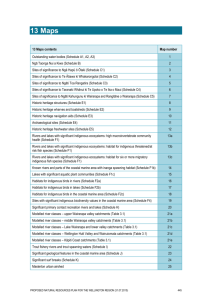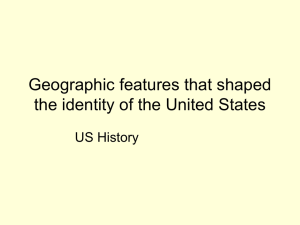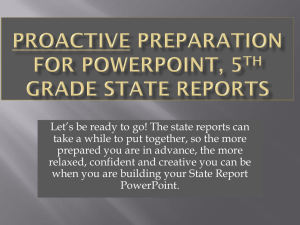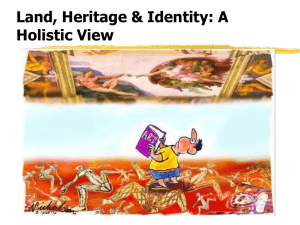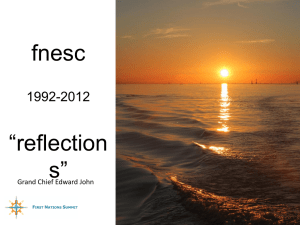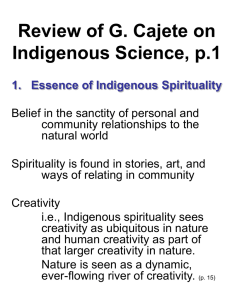Contents page (Word)
advertisement
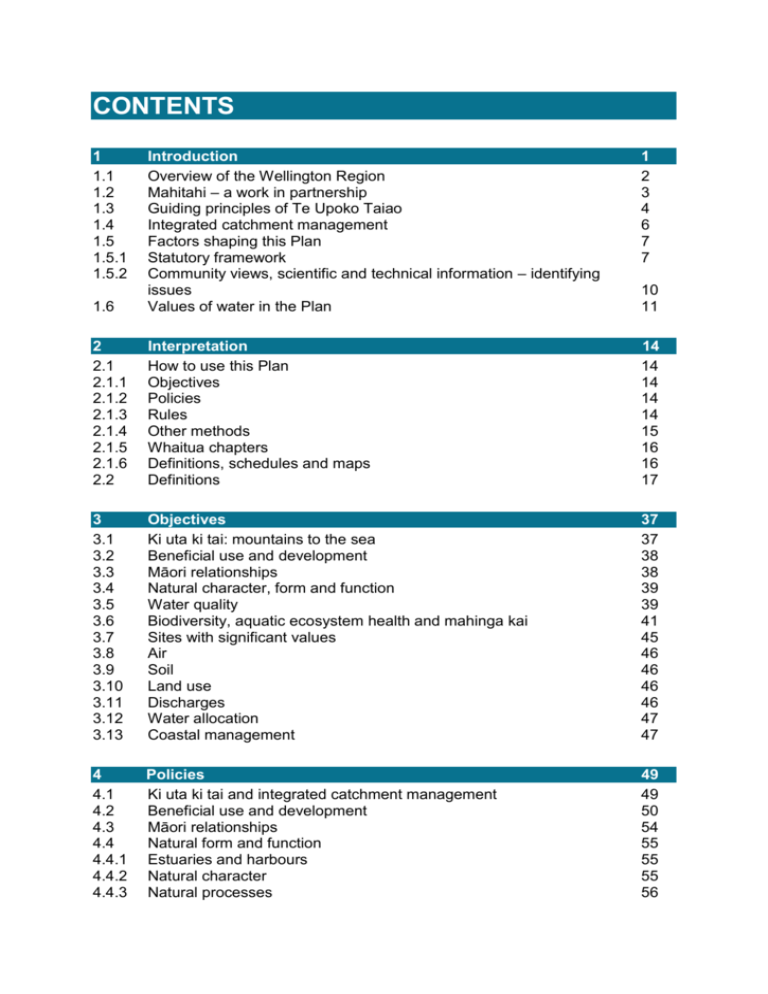
CONTENTS 1 1.1 1.2 1.3 1.4 1.5 1.5.1 1.5.2 1 2 3 4 6 7 7 1.6 Introduction Overview of the Wellington Region Mahitahi – a work in partnership Guiding principles of Te Upoko Taiao Integrated catchment management Factors shaping this Plan Statutory framework Community views, scientific and technical information – identifying issues Values of water in the Plan 2 2.1 2.1.1 2.1.2 2.1.3 2.1.4 2.1.5 2.1.6 2.2 Interpretation How to use this Plan Objectives Policies Rules Other methods Whaitua chapters Definitions, schedules and maps Definitions 14 14 14 14 14 15 16 16 17 3 3.1 3.2 3.3 3.4 3.5 3.6 3.7 3.8 3.9 3.10 3.11 3.12 3.13 Objectives Ki uta ki tai: mountains to the sea Beneficial use and development Māori relationships Natural character, form and function Water quality Biodiversity, aquatic ecosystem health and mahinga kai Sites with significant values Air Soil Land use Discharges Water allocation Coastal management 37 37 38 38 39 39 41 45 46 46 46 46 47 47 4 4.1 4.2 4.3 4.4 4.4.1 4.4.2 4.4.3 Policies Ki uta ki tai and integrated catchment management Beneficial use and development Māori relationships Natural form and function Estuaries and harbours Natural character Natural processes 49 49 50 54 55 55 55 56 10 11 4.4.4 4.5 4.6 4.6.1 4.6.2 4.6.3 4.6.4 4.6.5 4.7 4.8 4.8.1 4.8.2 4.8.3 4.8.4 4.8.5 4.8.6 4.8.7 4.8.8 4.8.9 4.8.10 4.8.11 4.8.12 4.9 4.9.1 4.9.2 4.9.3 4.9.4 4.9.5 4.9.6 4.9.7 4.10 4.10.1 4.10.2 4.10.3 Natural hazards 56 Biodiversity, aquatic ecosystem health and mahinga kai 58 Sites with significant values 60 Outstanding water bodies 60 Sites with significant indigenous biodiversity value 60 Sites with significant mana whenua values 61 Sites with significant historic heritage value 62 Natural features and landscapes and special amenity landscapes 63 Air quality 64 Discharges to land and water 66 Land and water 66 Discharges to water 68 Stormwater 70 Wastewater 73 Wastewater from vessels and offshore installations and biofoul cleaning 75 Contaminated land, hazardous substances and landfills 75 Hydraulic fracturing 76 Discharges to land 77 Land use 78 Earthworks and vegetation clearance 78 Livestock access and riparian management 78 Activities in beds of lakes and rivers 79 Taking, using, damming and diverting water 81 Minimum flows 82 Allocating water 82 Reasonable and efficient use of water 84 Managing adverse effects 85 Transferring water permits 86 Damming and diverting water 86 Constructing and managing bores 86 Coastal management 87 Primary coastal policies 87 Structures 88 Other activities in the coastal marine area 90 5 5.1 5.1.1 5.1.2 5.1.3 5.1.4 5.1.5 5.1.6 5.1.7 5.1.8 5.1.9 5.1.10 5.1.11 5.1.12 Rules Air quality Air quality other methods Outdoor burning Domestic fires Large scale combustion activities Chemical and metallurgical processes Cremation and incineration Dust generating activities Food, animal or plant matter manufacturing and processing Fuel storage Mobile sources Gas, water and wastewater processes Drying and kiln processes 93 94 96 96 97 97 101 105 106 107 108 108 108 109 5.1.13 5.1.14 5.1.15 5.2 5.2.1 5.2.2 5.2.3 5.2.4 5.2.5 5.2.6 5.2.7 5.2.8 5.3 5.3.1 5.3.2 5.3.3 5.3.4 5.3.5 5.3.6 5.3.7 5.3.8 5.3.9 5.4 5.4.1 5.4.2 5.4.3 5.4.4 5.4.5 5.5 5.5.1 5.5.2 5.5.3 5.5.4 5.5.5 5.5.6 5.5.7 5.5.8 5.6 5.6.1 5.6.2 5.6.3 5.6.4 5.7 5.7.1 5.7.2 5.7.3 5.7.4 5.7.5 5.7.6 5.7.7 Ground-based and aerial applications Fumigation All other discharges Discharges to water Discharges to water other methods Water discharges Stormwater Contaminated land and hazardous substances Water races and pumped drainage schemes Wastewater Biofoul cleaning All other discharges Discharges to land Discharges to land other methods Discharge of contaminants Biosolids Treated wastewater Drinking water treatment plant waste Fertiliser and animal effluent Vertebrate toxic agents Refuse, silage and compost All other discharges Land use Land use other methods Cultivation and break-feeding Livestock exclusion Earthworks and vegetation clearance Plantation forestry Wetlands and beds of lakes and rivers Wetlands and beds of lakes and rivers other methods Activities in wetlands general conditions Activities in wetlands Activities in beds of lakes and rivers general conditions Activities in beds of lakes and rivers Reclamation and placement of a dam All other activities in the beds of rivers and lakes Damming and diverting water Water allocation Water allocation other methods Take and use of water Transferring water permits Bore construction or alteration Coastal management Coastal management other methods Coastal management general conditions Maintenance, repair, additions and alterations to existing structures Removal or demolition of structures New and replacement structures (including temporary structures) Seawalls Heritage structures 109 112 113 114 115 115 119 122 123 124 124 125 127 128 128 135 136 142 142 145 146 148 150 151 151 151 153 154 156 158 158 159 163 165 177 178 178 180 181 181 184 186 188 192 192 198 201 202 209 211 5.7.8 5.7.9 5.7.10 5.7.11 5.7.12 5.7.13 5.7.14 5.7.15 5.7.16 5.7.17 5.7.18 5.7.19 5.7.20 Structures in the Commercial Port Area Boatsheds and swing moorings Occupation Surface water and foreshore activities General disturbance activities Motor vehicles on the foreshore Dredging All other destruction, damage or disturbance Deposition Dumping of waste or other matter Reclamation and drainage Destruction Introduction of plants 214 216 218 218 221 226 228 231 231 233 235 236 236 6 6.1 6.2 6.3 6.4 6.4.1 238 238 238 239 239 6.4.2 6.4.3 6.4.4 6.5 6.6 6.7 6.8 6.9 6.10 6.11 6.12 6.13 6.14 6.15 Other methods General Natural hazards Air quality Land and water Implementing the National Policy Statement for Freshwater Management Te Awarua-o-Porirua Harbour restoration Wairarapa Moana Improving water quality Rural land use Stormwater Contaminated land Waste reduction and efficient use of water and energy Biodiversity Coast Historic heritage Natural features and landscapes Mana whenua Contact recreation and Māori customary use Good management practice 7 7.1 7.2 Ruamāhanga Whaitua Policies Rules 248 248 249 8 8.1 8.2 Wellington Harbour and Hutt Valley Whaitua Policies Rules 264 264 265 9 9.1 9.2 Te Awarua-o-Porirua Whaitua Policies Rules 270 270 270 239 240 240 240 241 243 243 243 245 245 246 246 246 246 247 10 10.1 10.2 Kāpiti Coast Whaitu Policies Rules 271 271 272 11 11.1 11.2 Wairarapa Coast Whaitua Policies Rules 277 277 277 12 Schedules Schedule A: Outstanding water bodies Schedule A1: Rivers with outstanding indigenous ecosystem values Schedule A2: Lakes with outstanding indigenous ecosystem values Schedule A3: Wetlands with outstanding indigenous biodiversity values Schedule B: Ngā Taonga Nui a Kiwa Schedule C: Sites with significant mana whenua values Schedule C1: Sites of significance to Ngā Hāpu o Ōtaki Schedule C2: Sites of significance to Te Ᾱtiawa ki Whakarongotai Schedule C3: Sites of significance to Ngāti Toa Rangatira Schedule C4: Sites of significance to Taranaki Whānui ki te Upoko o te Ika a Maui Schedule C5: Sites of significance to Ngāti Kahungunu ki Wairarapa and Rangitāne o Wairarapa Schedule D: Statutory Acknowledgements Schedule D1: Statutory Acknowledgements from the Port Nicholson Block (Taranaki Whānui ki Te Upoko o Te Ika) Claims Settlement Act 2009 Schedule D2: Statutory Acknowledgements from the Ngāti Toa Rangatira Claims Settlement Act 2014 Schedule E: Sites with significant historic heritage values Schedule E1: Historic heritage structures Schedule E2: Historic heritage wharves and boatsheds Schedule E3: Historic heritage navigation aids Schedule E4: Archaeological sites Schedule E5: Historic heritage freshwater sites Schedule F: Ecosystems and habitats with significant indigenous biodiversity values Schedule F1: Rivers and lakes with significant indigenous ecosystems Schedule F1a: Known spawning and migration times for indigenous fish species Schedule F1b: Known rivers and parts of the coastal marine area with inanga spawning habitat Schedule F1c: Lakes with significant aquatic plant communities Schedule F2: Habitats for indigenous birds Schedule F2a: Habitats for indigenous birds in rivers Schedule F2b: Habitats for indigenous birds in lakes Schedule F2c: Habitats for indigenous birds in the coastal marine area Schedule F3: Identified significant natural wetlands Schedule F3a: Contents of restoration management plans 278 279 279 279 279 281 294 294 295 297 299 300 304 304 313 333 333 335 338 339 345 352 352 376 379 380 380 380 381 383 393 399 Schedule F4: Sites with significant indigenous biodiversity values in the coastal marine area Schedule F5: Habitats with significant indigenous biodiversity values in the coastal marine area Schedule G: Principles to be applied when proposing and considering mitigation and offsetting in relation to biodiversity Schedule H: Contact recreation and Māori customary use Schedule H1: Regionally significant primary contact recreation water bodies Schedule H2: Priorities for improvement of fresh and coastal water quality for contact recreation and Māori customary use Schedule I: Important trout fishery rivers and spawning waters Schedule J: Significant geological features in the coastal marine area Schedule K: Significant surf breaks Schedule L: Air quality Schedule L1: Regional ambient air quality targets Schedule L2: Hazardous air pollutants Schedule M: Community drinking water supply abstraction points Schedule M1: Surface water community drinking water supply abstraction points Schedule M2: Groundwater community drinking water supply abstraction points Schedule N: Stormwater management strategy Schedule O: Plantation forestry harvest plan Schedule P: Classifying and managing groundwater and surface water connectivity Schedule Q: Reasonable and efficient use criteria Schedule R: Guideline for stepdown allocations Schedule S: Guideline for measuring and reporting of water takes Schedule T: Pumping test Schedule U: Trigger levels for river and stream mouth cutting 400 405 407 410 410 411 413 415 418 420 420 422 428 428 429 431 433 434 436 438 439 440 442 13 Maps 445 Map 1: Outstanding water bodies (Schedule A1, A2, A3) Map 2: Ngā Taonga Nui a Kiwa (Schedule B) Map 3: Sites of significance to Ngā Hapū ō Ōtaki (Schedule C1) Map 4: Sites of significance to Te Ātiawa ki Whakarongotai (Schedule C2) Map 5: Sites of significance to Ngāti Toa Rangatira (Schedule C3) Map 6: Sites of significance to Taranaki Whānui ki Te Upoko o Te Ika o Maui (Schedule C4) Map 7: Sites of significance to Ngāti Kahungunu ki Wairarapa and Rangitāne o Wairarapa (Schedule C5) Map 8: Historic heritage structures (Schedule E1) Map 9: Historic heritage wharves and boatsheds (Schedule E2) Map 10: Historic heritage navigation aids (Schedule E3) Map 11: Archaeological sites (Schedule E4) Map 12: Historic heritage freshwater sites (Schedule E5) Map 13a: Rivers and lakes with significant indigenous ecosystems: high macroinvertebrate community health (Schedule F1) Map 13b: Rivers and lakes with significant indigenous ecosystems: habitat for indigenous threatened/at risk fish species (Schedule F1) Map 13c: Rivers and lakes with significant indigenous ecosystems: habitat for six or more migratory indigenous fish species (Schedule F1) Map 14: Known rivers and parts of the coastal marine area with inanga spawning habitat (Schedule F1b) Map 15: Lakes with significant aquatic plant communities (Schedule F1c) Map 16: Habitats for indigenous birds in rivers (Schedule F2a) Map 17: Habitats for indigenous birds in lakes (Schedule F2b) Map 18: Habitats for indigenous birds in the coastal marine area (Schedule F2c) Map 19: Sites with significant indigenous biodiversity values in the coastal marine area (Schedule F4) Map 20: Significant primary contact recreation rivers and lakes (Schedule H) Map 21a: Modelled river classes – upper Wairarapa valley catchments (Table 3.1) Map 21b: Modelled river classes – middle Wairarapa valley catchments (Table 3.1) Map 21c: Modelled river classes – Lake Wairarapa and lower valley catchments (Table 3.1) Map 21d: Modelled river classes – Wellington Hutt Valley and Wainuiomata catchments (Table 3.1) Map 21e: Modelled river classes – Kāpiti Coast catchments (Table 3.1) Map 22: Trout fishery rivers and trout spawning waters (Schedule I) Map 23: Significant geological features in the coastal marine area (Schedule J) Map 24: Significant surf breaks (Schedule K) Map 25: Masterton urban airshed Map 26: Surface water community drinking water supply protection areas (incorporates Schedule M1) Map 27a: Groundwater community drinking water supply protection areas – Wairarapa (incorporates Schedule M2) Map 27b: Groundwater community drinking water supply protection areas – Hutt Valley (incorporates Schedule M2) Map 27c: Groundwater community drinking water supply protection areas – Kāpiti Coast (incorporates Schedule M2) Map 28: Water races in the Wairarapa Map 29: Lowland areas for Category 2 surface water bodies Map 30: Hutt Valley aquifer zone in Wellington Harbour (Port Nicholson) Map 31: Boatshed areas Map 32: Commercial port, Lambton Harbour Area & noise control lines – Lambton Harbour Map 33: Commercial port area & noise control lines – Miramar and Burnham Wharves Map 34: Commercial port area – Seaview Wharf Map 35: Titahi Bay fossil forest (indicative) Map 36: Mooring areas Wellington Harbour (Port Nicholson) – Evans Bay Map 37: Mooring areas Wellington Harbour (Port Nicholson) – Whiorau/Lowry Bay Map 38: Mooring areas Island Bay Map 39: Mooring areas Te Awarua-o-Porirua Harbour – Onepoto Map 40: Mooring areas Te Awarua-o-Porirua Harbour – Mana Map 41: Mooring areas Te Awarua-o-Porirua Harbour – Pauatahanui Arm Maps 42-48: Coastal marine area and river mouth boundaries Map 49: Navigation protection areas in Wellington Harbour (Port Nicolson) Map 50: Wellington International Airport height restrictions Map 51: Kapiti Coast Airport approach gradients Map 52: Cook Strait cable protection zone
